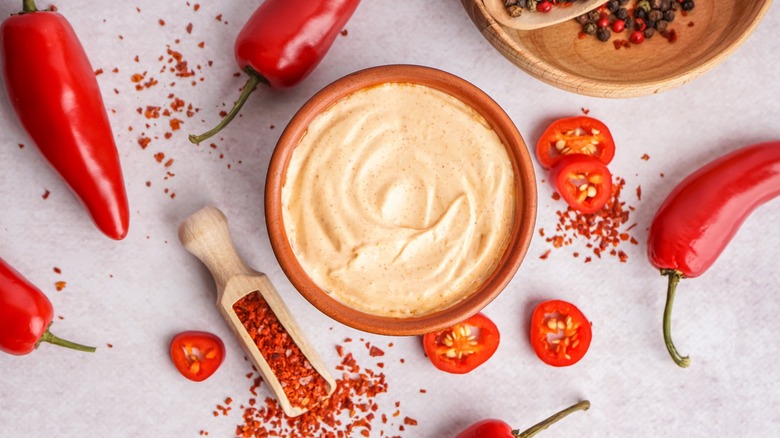Hear Us Out: Hot Sauce Might Be What Your Salad Dressing Is Missing
Spices make the world go round, but spicy foods bring a splash of variety to life, and there's no better way to incorporate a little heat into a dish than hot sauce. Although some may avoid spicy condiments due to their heat tolerance, a little hot sauce might make you happy if you let it. Moreover, despite being a hot commodity now, hot sauces initially existed as an incredibly simple seasoning and stayed that way for a long time, utilized by people worldwide. Nevertheless, if you're still not sold on using it as a flavor-enhancing topping or garnish, there's one way you incorporate it into a meal and remove some of the burn: as a salad dressing complement. Talk about a must-try.
The idea may sound a little offputting at first, but it makes sense when considering what spicy sauces are made of, especially since most of the components are common elements usually found in ... dressing. As a result, they tend to meld quite well with other flavors you'd typically drizzle on greens.
What goes into hot sauce
Hot sauces are like fingerprints — although there may be similarities, no two are alike, and there are hundreds (if not thousands) of variations out there. However, most have the same essential elements: hot peppers, some acid (usually vinegar), and salt. Other than that, the rest of the components are left to the imagination, which allows for delightful innovation concerning its use as an ingredient. And the experts agree with this notion, as Chef Whitney Otawka of Greyfield Inn told Garden & Gun, "There are sauces I cook with and sauce I eat," she stated. "I cook with higher-acid sauces like Tabasco, Lousiana, and Crystal."
Still, although Otawka uses the term "cooking," that doesn't necessarily mean hot sauce is limited to heated applications. Her thoughts on using a sauce with more acidity are sound, especially if you're trying to tamp down the warmth. Either way, the extra customizable elements make these tasty and piquant toppings adaptable. For example, the basic components of a spicy condiment like harissa generally include other ingredients such as garlic, salt, olive oil, lemon juice or vinegar, caraway, cumin, and coriander. Thus, harissa works as a perfect addition to a simple vinaigrette like the one in this fennel salad with red onion, parsley, and lemon, especially if you decided to grill the fennel after slicing.
Experiment with hot sauce and dressings
The best thing to do when beginning your journey into adding hot sauce to salad dressing is to try different combinations. Maybe milder heat is your thing, or an overly spicy one isn't so bad, but it just needs to be subdued. Well, then dressings can help, especially if it's dairy-based. For instance, ingredients like buttermilk, yogurt, cheese, or sour cream (all everyday items found in salads), take some of the edge off the fieriness by hindering the spice from fully interacting with your sense of taste. After all, there's a reason behind dipping those hot wings in ranch or blue cheese dressing.
Also, each pepper is different. Putting the Scoville units aside (the measurement that indicates how spicy it will be), distinct chilies have unique flavor profiles. Items like banana, pimento, or shishito peppers tend to be sweet (despite varying in heat), while poblanos and hatch chilies are more earthlike. Moreover, for those brave enough, habaneros have a fruit-esque undertone that complements produce like mango and pineapple. So, picking the right hot sauce matters.
Regardless of which direction you go with hot sauce, whether purchasing a bottle from the nearest grocery store or making your own, there's room for error but also a little fun. Besides, who doesn't like to play with their food from time to time? Just make sure to have a glass of milk handy if needed.


